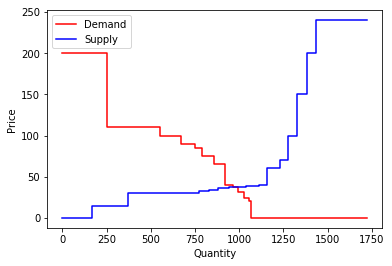Creating a new mechanism¶
[1]:
import numpy as np
import pandas as pd
import pymarket as pm
import matplotlib.pyplot as plt
from pprint import pprint
One of the advantages of PyMarket is the ability to easily implement and test a new idea for a mechanism. Here we will show how to implement a new mechanism and use it.
The uniform price mechanism¶
We are going to implement a uniform price mechanism that charges every trading player the clearing price.
As a reference we are going to be implement the example Here
We can begin by adding the corresponding bids to a new market
[2]:
mar = pm.Market()
buyers_names = ['CleanRetail', 'El4You', 'EVcharge', 'QualiWatt', 'IntelliWatt']
mar.accept_bid(250, 200, 0, True) # CleanRetail 0
mar.accept_bid(300, 110, 1, True) # El4You 1
mar.accept_bid(120, 100, 2, True) # EVcharge 2
mar.accept_bid( 80, 90, 3, True) # QualiWatt 3
mar.accept_bid( 40, 85, 4, True) # IntelliWatt 4
mar.accept_bid( 70, 75, 1, True) # El4You 5
mar.accept_bid( 60, 65, 0, True) # CleanRetail 6
mar.accept_bid( 45, 40, 4, True) # IntelliWatt 7
mar.accept_bid( 30, 38, 3, True) # QualiWatt 8
mar.accept_bid( 35, 31, 4, True) # IntelliWatt 9
mar.accept_bid( 25, 24, 0, True) # CleanRetail 10
mar.accept_bid( 10, 21, 1, True) # El4You 11
sellers_names = ['RT', 'WeTrustInWind', 'BlueHydro', 'KøbenhavnCHP', 'DirtyPower', 'SafePeak']
mar.accept_bid(120, 0, 5, False) # RT 12
mar.accept_bid(50, 0, 6, False) # WeTrustInWind 13
mar.accept_bid(200, 15, 7, False) # BlueHydro 14
mar.accept_bid(400, 30, 5, False) # RT 15
mar.accept_bid(60, 32.5, 8, False) # KøbenhavnCHP 16
mar.accept_bid(50, 34, 8, False) # KøbenhavnCHP 17
mar.accept_bid(60, 36, 8, False) # KøbenhavnCHP 18
mar.accept_bid(100,37.5, 9, False) # DirtyPower 19
mar.accept_bid(70, 39, 9, False) # DirtyPower 20
mar.accept_bid(50, 40, 9, False) # DirtyPower 21
mar.accept_bid(70, 60, 5, False) # RT 22
mar.accept_bid(45, 70, 5, False) # RT 23
mar.accept_bid(50, 100, 10, False) # SafePeak 24
mar.accept_bid(60, 150, 10, False) # SafePeak 25
mar.accept_bid(50, 200, 10, False) # SafePeak 26
[2]:
26
[3]:
12, 15, 22, 23
[3]:
(12, 15, 22, 23)
[4]:
mar.plot()

Implementing the mechanism¶
All market mechanisms take as arguements a bids dataframe (as well as possibly extra parameters) and returns a TransactionManager and an extras dictionary.
[13]:
def uniform_price_mechanism(bids: pd.DataFrame) -> (pm.TransactionManager, dict):
trans = pm.TransactionManager()
buy, _ = pm.bids.demand_curve_from_bids(bids) # Creates demand curve from bids
sell, _ = pm.bids.supply_curve_from_bids(bids) # Creates supply curve from bids
# q_ is the quantity at which supply and demand meet
# price is the price at which that happens
# b_ is the index of the buyer in that position
# s_ is the index of the seller in that position
q_, b_, s_, price = pm.bids.intersect_stepwise(buy, sell)
buying_bids = bids.loc[bids['buying']].sort_values('price', ascending=False)
selling_bids = bids.loc[~bids['buying']].sort_values('price', ascending=True)
## Filter only the trading bids.
buying_bids = buying_bids.iloc[: b_ + 1, :]
selling_bids = selling_bids.iloc[: s_ + 1, :]
# Find the long side of the market
buying_quantity = buying_bids.quantity.sum()
selling_quantity = selling_bids.quantity.sum()
if buying_quantity > selling_quantity:
long_side = buying_bids
short_side = selling_bids
else:
long_side = selling_bids
short_side = buying_bids
traded_quantity = short_side.quantity.sum()
## All the short side will trade at `price`
## The -1 is there because there is no clear 1 to 1 trade.
for i, x in short_side.iterrows():
t = (i, x.quantity, price, -1, False)
trans.add_transaction(*t)
## The long side has to trade only up to the short side
quantity_added = 0
for i, x in long_side.iterrows():
if x.quantity + quantity_added <= traded_quantity:
x_quantity = x.quantity
else:
x_quantity = traded_quantity - quantity_added
t = (i, x_quantity, price, -1, False)
trans.add_transaction(*t)
quantity_added += x.quantity
extra = {
'clearing quantity': q_,
'clearing price': price
}
return trans, extra
Wrapping the algorithm as a mechanism¶
[14]:
# Observe that we add as the second argument of init the algorithm just coded
class UniformPrice(pm.Mechanism):
"""
Interface for our new uniform price mechanism.
Parameters
-----------
bids
Collection of bids to run the mechanism
with.
"""
def __init__(self, bids, *args, **kwargs):
"""TODO: to be defined1. """
pm.Mechanism.__init__(self, uniform_price_mechanism, bids, *args, **kwargs)
Adding the new mechanism to the list of available mechanism of the market¶
[15]:
pm.market.MECHANISM['uniform'] = UniformPrice
Running the new mechanism and comparing it with Huang’s and P2P¶
[24]:
stats = {}
for mec in ['uniform', 'huang', 'p2p']:
t, e = mar.run(mec)
stat = mar.statistics()
stats[mec] = stat
Profits for the players in the different mechanism¶
[33]:
profits = pd.DataFrame([v['profits']['player_bid'] for k, v in stats.items()]).T
profits.columns = stats.keys()
profits
[33]:
| uniform | huang | p2p | |
|---|---|---|---|
| 0 | 42275.0 | 41529.375 | 22890.0 |
| 1 | 24375.0 | 23849.375 | 12980.0 |
| 2 | 7500.0 | 7246.250 | 3150.0 |
| 3 | 4215.0 | 3997.500 | 2630.0 |
| 4 | 2012.5 | 1816.875 | 1162.5 |
| 5 | 7500.0 | 7500.000 | 14647.5 |
| 6 | 1875.0 | 1875.000 | 810.0 |
| 7 | 4500.0 | 4500.000 | 18500.0 |
| 8 | 565.0 | 565.000 | 3910.0 |
| 9 | 0.0 | 0.000 | 4570.0 |
| 10 | 0.0 | 0.000 | 375.0 |
Percentage traded by mechanism¶
[36]:
traded = pd.DataFrame([v['percentage_traded'].round(3) for k, v in stats.items()]).T
traded.columns = stats.keys()
traded
[36]:
| uniform | huang | p2p | |
|---|---|---|---|
| 0 | 0.934 | 0.883 | 0.995 |
Percentage of the maximum social welfare achieved by mechanism¶
[38]:
welfare = pd.DataFrame([v['percentage_welfare'].round(3) for k, v in stats.items()]).T
welfare.columns = stats.keys()
welfare
[38]:
| uniform | huang | p2p | |
|---|---|---|---|
| 0 | 1.0 | 0.98 | 0.903 |
[ ]: